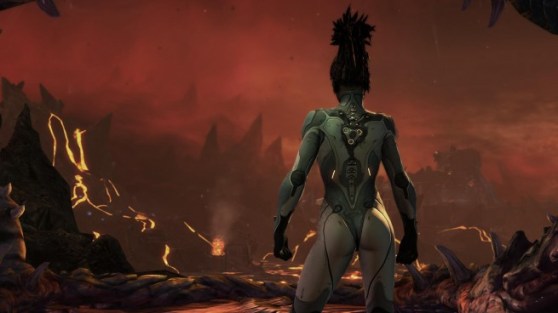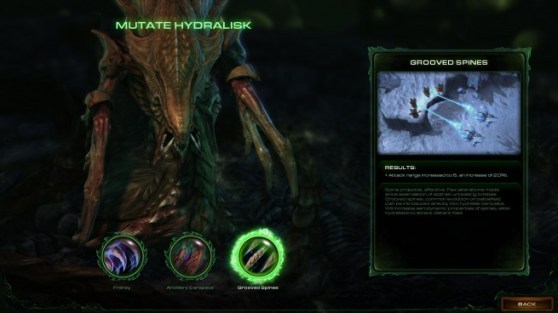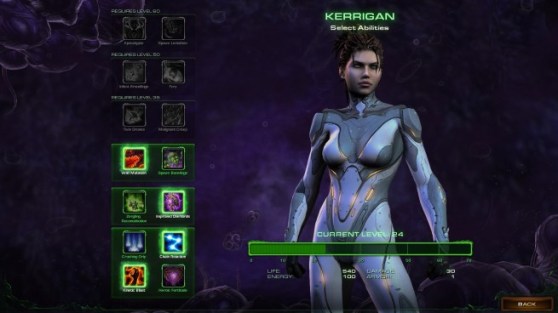Check out GamesBeat’s StarCraft II: Heart of the Swarm review here.
Welcome to GamesBeat’s StarCraft II: Heart of the Swarm guide. Below we’ll lay out all of the abilities Kerrigan can unlock as well as the mutations and evolutions that are eventually available to her swarm.
A quick note before we start: While you’ll probably collect plenty of achievements just through playing the campaign normally, don’t sweat missing any on your first run. After you’ve beaten it, you will unlock the Master Archives, where you can replay any mission on any difficulty with optimized abilities and units. It’s kind of like a New Game+. Kind of.
Since you can freely switch mutations and abilities between missions, I won’t really go into those much. But since evolution choices are permanent, I’ll give some quick insight into what I chose and how that worked out for me. Feel free to share your own thoughts and strategies in the comments below.
Mutations
Each Zerg unit has three different mutations. You can switch mutations anytime between missions. Sadly, you won’t really know what you need until you’re in the mission. Perhaps in the upcoming Legacy of the Void expansion, the Protoss will have some sort of intelligence-gathering capability that tells the player what to expect on the battlefield.
Zergling
- Adrenal Overload: +50% attack speed.
- Hardened Carapace: Gain an additional 10 HP.
- Metabolic Boost: +60% movement speed.
Baneling
- Corrosive Acid: Increase damage to primary target by 100%
- Regenerative Acid: Heals nearby friendly units and structures.
- Rupture: Increase splash damage area by 50%.
Roach
- Adaptive Plating: Gain +3 armor when life falls below 50%
- Hydriodic Bile: Gain +8 damage vs. light units.
- Tunneling Claws: Move at full speed when burrowed, and gain 100% life regen rate.
Hydralisk
- Ancillary Carapace: Gain +20 HP.
- Frenzy: Gain +50% attack speed for 15 seconds, with 30 second cool down.
- Grooved Spines: Gain +1 attack range.
Mutalisk
- Vicious Glave: Attacks deal increased damage and travel further, bouncing three more times for up to six targets.
- Rapid Regeneration: Regenerates 10 life per second while out of combat after a minimum of 5 seconds.
- Sundering Glave: Gains +9 damage vs. armored targets (an increase of 100%), but attacks no longer bounce to additional targets.
Swarm Host
- Burrow: Swarm Hosts can now burrow into the ground, preventing them from being seen by enemies without detection while still being able to spawn Locusts.
- Rapid Incubation: Locusts spawn 20% faster.
- Pressurized Glands: Locusts can attack both ground and air units.
Ultralisk
- Burrow Charge: Ultralisk burrows and charges toward a unit; when it erupts from the ground, all nearby enemy units are knocked back and stunned for 2 seconds.
- Tissue Assimilation: Gain life equal to 40% of all damage dealt from normal attacks.
- Pressurized Glands: Gains +20 splash damage (an increase of 400%), dealing equal damage to both primary and secondary targets now.
Evolutions
Through special Evolution Missions, you can eventually evolve each type of Zerg unit. Unlike mutations, however, an evolution choice is irreversible, meaning whatever evolution you don’t pick is permanently disabled. Note that while replaying the game via the Master Archives you can choose between evolutions as if they were mutations.
Zergling
- Raptor Strains: Gains the ability to jump up and down cliffs, leap over obstacles and onto targets from range, and gains +2 damage (40% increase).
- Swarm Strains: Spawn 3 Zerglings per egg, and their spawn speed near instant.
Cliffs don’t really play into the campaign that much, so there’s little need for the Raptorlings. However, combining the Swarm Strain evolution with Kerrigan’s Zergling Reconstitution ability means you can always have a massive Zerg army available on the cheap.
Baneling
- Splitter Strain: Banelings split into smaller Banelings upon detonation, each smaller Baneling does 5 damage.
- Hunter Strain: Banelings gain the ability to jump up and down cliffs as well as leap toward opponents.
The Splitters deal very little damage, and while it does add up, the Hunter Strain’s ability to close in on enemies more quickly means they’re less likely to get gunned down on the way to their target.
Roach
- Corpser Strain: Enemies damaged by the Roach will spawn two Roachlings if killed quickly.
- Vile Strain: Attacks slow enemy movement and attack speeds by 75% (20% for heroes).
The Roachlings are incredibly weak, so sacrificing them in order to slow enemies down to a crawl is not really a choice at all. The Vile Strain is extremely useful against powerful enemies, especially when you brought the wrong units to the fight.
Hydralisk
- Impaler Strain: Can morph into an Impaler, which attacks units from a distance while burrowed. Especially effective against armored units.
- Lurker Strain: Can morph into a Lurker, which attacks multiple enemies in a line while burrowed. Effective against light ground units.
By the time you can evolve the Hydralisk, light ground units aren’t much of a problem. However, using the Impaler, you can pretty much take out most enemy outposts or even bases by burrowing out of range and slowly working your way in, impaling all units and structures. They won’t even fight back since they can’t see you. Just be mindful of certain scout units and towers as they have detection capabilities.
Mutalisk
- Brood Lord Strain: Can morph into a Brood Lord, which besieges ground targets from long range with spawned Broodlings.
- Viper Strain: Can morph into a Viper, which can pull distant units close, slow enemy ground units and prevent them from attacking for several seconds, or drain life from allied units to restore its own energy. Also enables air-to-air combat.
The Brood Lords are very effective at overwhelming enemies and structures from a distance, but the Vipers have two extremely useful abilities. They can pull enemy units (like tanks in siege mode) off of cliffs or away from bases so that you can gang up on them, and they can poison an area, causing any units to slow down and stop attacking for 10 seconds. This was a hard choice, but I eventually went with Brood Lords just because they complement my Swarm Hosts.
Swarm Host
- Carrion Strain: Spawns flying Locusts that can attack ground targets. Flying Locusts are faster and deal 50% more damage than regular Locusts, but have 25% less life.
- Creeper Strain: Swarm Host generates creep while burrowed or rooted. Enables Deep Tunnel ability to quickly travel to any location with creep.
The Creeper Strain’s creep generation passive ability enables you to easily place creep anywhere rather than slowly trying to spread it with a Creep Tumor. While the flying Locusts from the Carrion Strain can defeat enemies more quickly, Deep Tunneling a giant group of Swarm Hosts to and from your base as needed becomes a lifesaver in the later levels. A common strategy I used was to send a bunch of Zerglings into a base to draw fire and then plant a Swarm Host in the middle of the base to generate creep. This allowed me to instantly warp dozens of Swarm Hosts from the safety of my own base to the target area and quickly overwhelm it.
Ultralisk
- Noxious Strain: Emits Noxious Cloud that deals 5 damage per second to nearby enemy ground units. Toxic Blast ability deals 20 damage to enemy ground units and structures.
- Torrasque Strain: When killed, enters a Chrysalis for a short period before resurrecting with full health. Rebirth cooldown is 60 seconds.
While the Noxious Strain definitely makes the Ultralisk even more destructive, you just can’t deny the value in resurrecting these units. They’re extremely expensive and take time to make, so having a dead one come back to life on the frontline is the obvious choice. Combine that with the Tissue Assimilation ability and Ultralisks last for a very long time.
Kerrigan
As Kerrigan gains levels, you unlock new ability tiers. Each tier has two abilities (with a third ability set being unlocked halfway through the campaign), and you can choose between them between missions. Note that leveling Kerrigan to 70 does not unlock any new abilities, only an achievement.
Click here to see the fully unlocked Ability screen at level 70 (mild spoilers).
Tier 1: Level 0
- Kinetic Blast: Kerrigan deals 300 damage to a target unit or structure from long range.
- Heroic Fortitude: Kerrigan gains +200 maximum life. Life regeneration rate increased by 100%.
- Leaping Strike: Kerrigan leaps to her target and deals 150 damage to it. Can be used without a target to travel quickly. Kerrigan also gains a passive +10 damage increase, but attack range is reduced by 3.
Tier 2: Level 0
- Crushing Grip: Enemies in target area are stunned for 3 seconds and take 30 damage over time.
- Chain Reaction: Kerrigan’s attacks deal normal damage to her target and then jump to additional nearby enemies. Deals 10 damage to up to four secondary targets.
- Psionic Shift: Kerrigan dashes through enemies dealing 50 damage to any in her path. Overall movement speed is also increased by 30%.
Tier 3: Level 10
- Zergling Reconstitution: Killed Zerglings respawn from your primary Hatchery at no cost. Respawns up to 10 Zerglings every 30 seconds until all Zerglings have returned to life.
- Improved Overlords: Overlords morph instantly and provide 50% more supply.
- Automated Extractors: Extractors automatically extract vespene gas without Drones.
Tier 4: Level 20
- Wild Mutation: Friendly Zerg units in the target area gain +200 maximum life and 100% increased attack speed for 10 seconds. Does not affect heroic units.
- Spawn Banelings: Kerrigan spawns six Banelings with timed life.
- Mend: Heals Kerrigan for 150 life and friendly biological units nearby for 50 life. An additional 50% of the amounted healed regenerates over 15 seconds.
Tier 5: Level 35
- Twin Drones: Drones morph in groups of two at no additional cost.
- Malignant Creep: Your units and structures gain increased life regeneration and 30% increased attack speed on creep. Creep Tumors spread creep faster and farther.
- Vespene Efficiency: Vespene gas harvesting efficiency increased by 25%.
Tier 6: Level – 50
- Infest Broodlings: Enemies damaged by Kerrigan become infested and spawn two Broodlings with timed life if killed quickly.
- Fury: Each attack temporarily increases Kerrigan’s attack speed by 15%. Can stack up to 75%.
- Ability Efficiency: Kerrigan’s abilities have their cooldown and energy cost reduced by 20%.
Tier 7: Level 60*
- Apocalypse: Deals 300 damage to enemy units and 700 damage to enemy structures in a large area.
- Spawn Leviathan: Summons a mighty flying Leviathan with timed life that deals massive damage to ground and air units and has energy-based abilities.
- Drop-Pods: Delivers 40 Primal Zerglings, 5 Primal Roaches, and 5 Primal Hydralisks with timed life to the battlefield.
*Note that all Tier 7 abilities cost 100 energy and start on a cooldown, meaning you have to wait 5 minutes to use them (or 4 minutes with Ability Efficiency).
VentureBeat's mission is to be a digital town square for technical decision-makers to gain knowledge about transformative enterprise technology and transact. Learn More




